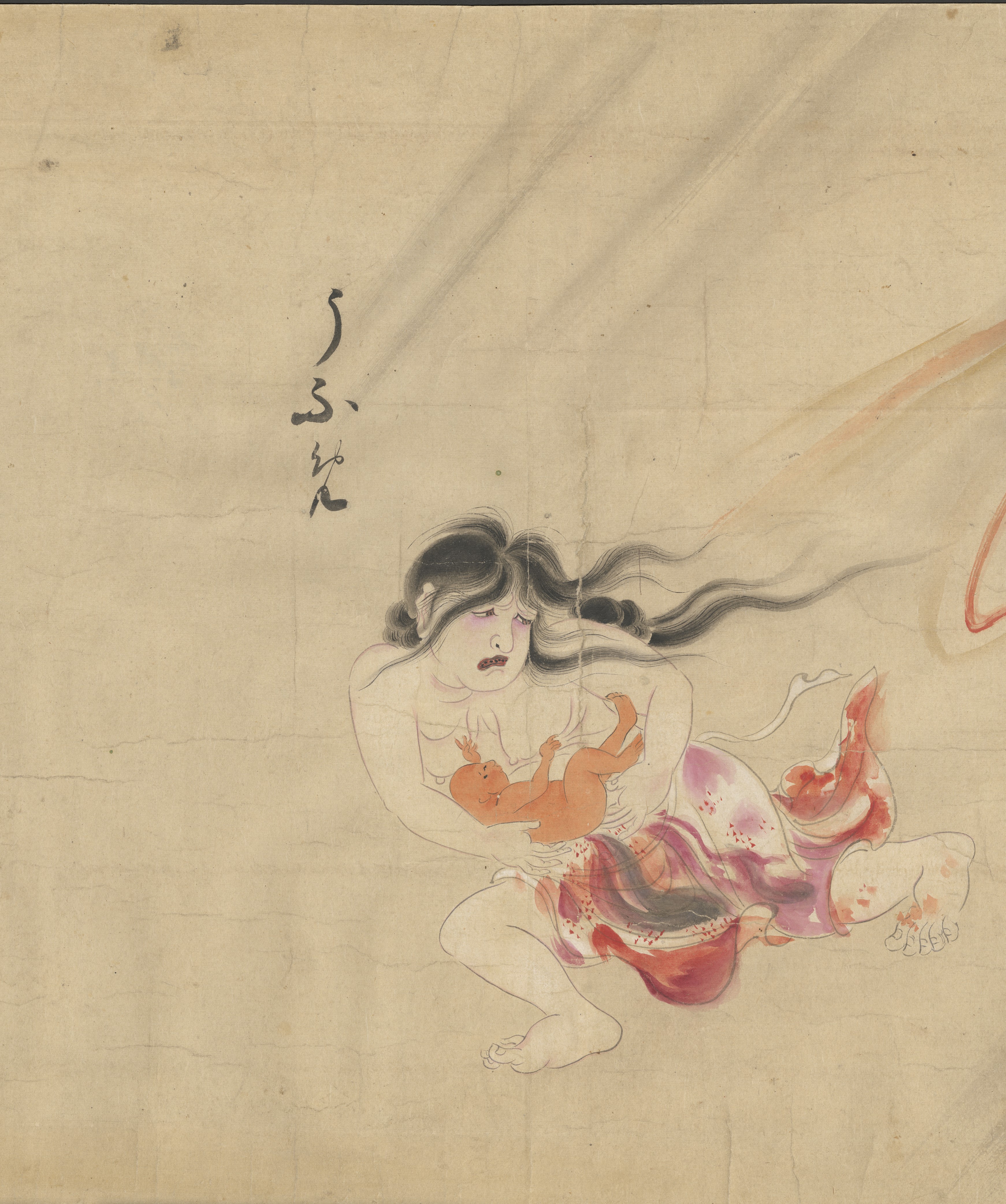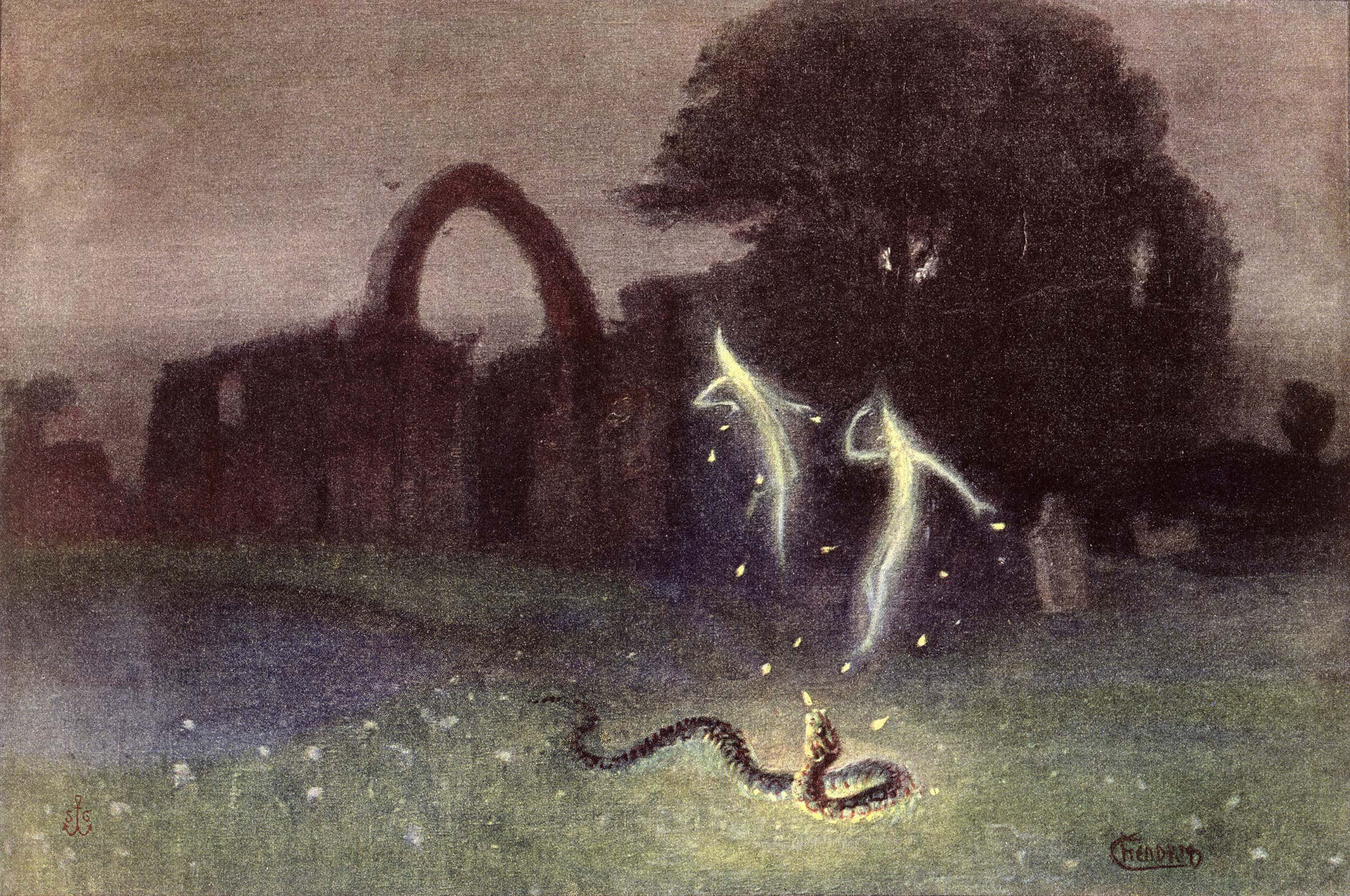|
Ubume
are Japanese yōkai of pregnant women. They can also be written as '. Throughout folk stories and literature the identity and appearance of ubume varies. However, she is most commonly depicted as the spirit of a woman who has died during childbirth. Passersby will see her as a normal-looking woman carrying a baby. She will typically try to give the passerby her child then disappear. When the person goes to look at the child in their arms, they discover it is only a bundle of leaves or large rock. Etymology Some Japanese sources coopt the Chinese name (pinyin: , "lady capturing-bird", translated as "wench bird") and read it Japanese style as "ubume" or "ubumedori". From Chinese sources (cf. below), Japanese learned men learned that this "wench bird" had the characteristic that "in front of their chest they have two breasts" (or rather "a pair of teats/wikt:mammary, mammaries"). Thus the creature's name is also styled (''ubame'', "Wet nurse, wetnurse bird"), with the expla ... [...More Info...] [...Related Items...] OR: [Wikipedia] [Google] [Baidu] |
Urabe No Suetake
was a samurai of the Heian period (794 – 1185) in the service of Minamoto no Yorimitsu (948 – 1021), a regent of the Fujiwara clan. Suetake was formally known as , and also appears in literature as and . Suetake assisted Yorimitsu throughout his life, being referred to as one of ''Shitennō (samurai), Shitennō'', or "Four Guardian Kings" of Yorimitsu. Suetake originated from the House of Seiryū (Blue Dragon). In addition to Suetake, the other ''Shitennō'' of Yorimitsu were Usui Sadamitsu, Kintarō, and Watanabe no Tsuna. His ancestor is Sakanoue no Tamuramaro which he inherited his bow. Suetake is the subject of a tale in the Konjaku Monogatarishū, a collection of folk legends compiled in the late Heian period. The Japanese tale in which Suetake appears is known as Ōeyama. He died in 1022 at the age of 73. On a dark night, Taira no Suetake was crossing a river on horseback when he came across a Ubume holding a child in the middle of the river, who handed him ... [...More Info...] [...Related Items...] OR: [Wikipedia] [Google] [Baidu] |
Guhuoniao
The (, "wench bird") is a legendary bird from Chinese folklore. It is described in Chinese texts such as Western Jin natural history book (, "Record of the Mysterious Center", 3-4th cent.), and the Ming period pharmacopoeia ''Bencao Gangmu'' (16th cent.) which collates information from this and other sources. Nomenclature The ''guhuoniao'' (, "wench bird") has had several aliases, such as (, "mother's milk bird", or in Japanese, " wetnurse bird), (, "nighttime traveling girl"), (, "celestial emperor's young girl"), (, "innocent bird"), (, "hidden flying"), (, "hook star ); (, "demon bird"), ''yi xi'' (), It later earned the name ( "demon cart"). General description The wench bird, according to the ''Bencao Gangmu'', is a kind of demon-spirit (''guishen'' ) that takes human lives, according to the "Record of the Mysterious Center".. That is to say, it extracts the two types of human soul, the ''hun'' and ''po'' , according to Chen Canqi (author of the , 739). It ca ... [...More Info...] [...Related Items...] OR: [Wikipedia] [Google] [Baidu] |
Miscellaneous Morsels From Youyang
The ''Miscellaneous Morsels from Youyang'' () is a book written by Duan Chengshi in the 9th century, during the Tang Dynasty. It focuses on miscellany of Chinese and foreign legends and hearsay, reports on natural phenomena, short anecdotes, and tales of the wondrous and mundane, as well as notes on such topics as medicinal herbs and tattoos. ''Youyang'' refers to the south slope of ''Mount You'', a small hill located in what is now Huaihua, Hunan. The book is divided into 30 volumes, containing unusually varied content in over thirteen hundred entries that describe the world that Duan Chengshi heard about, read of, or personally observed. Several tales from the volume are quoted in the ''Taiping Guangji''. The '' Ye Xian'', a story similar to the fairy tale ''Cinderella'', appears in Chapter 21. The story was allegedly told by Duan's servant Li Shiyuan, a native of what is now Nanning. It is set during the late 3rd century BC. The exact location is unknown, but the most likel ... [...More Info...] [...Related Items...] OR: [Wikipedia] [Google] [Baidu] |
Ōnuma District, Fukushima
Onuma, Ōnuma or Oonuma may refer to: * Onuma (surname), Japanese surname * Ōnuma District, district of Fukushima Prefecture, Japan *Ōnuma Station, train station in Hokkaido Prefecture, Japan *Ōnuma Quasi-National Park is a quasi-national park on the Oshima Peninsula in southwest Hokkaidō, Japan. The park encompasses the volcanic as well as the and ponds, which abut against the west slope of the mountain. The park, which was designated as quasi-national ..., national park in Hokkaido Prefecture, Japan, with a famous pond also called Ōnuma People with the given name * Onuma Sittirak (born 1986), Thai volleyball player {{disambiguation ... [...More Info...] [...Related Items...] OR: [Wikipedia] [Google] [Baidu] |
Kaneyama, Fukushima
is a town located in Fukushima Prefecture, Japan. , the town had an estimated population of 1972, in 1037 households and a population density of 6.7 persons per km2. The total area is . Kaneyama is noted for its spectacular scenery. Geography Kaneyama is located in mountainous northwest of the Aizu region of Fukushima Prefecture, bordered Niigata Prefecture to the west. Kaneyama has no town center, but is an artificial construct made up of a number of small villages scattered alongside the Tadami River. Kaneyama has many hot springs. *Mountains : Mount Mikagura (1386.5 m), Mount Takamori *Rivers : Tadami River *Lakes: Lake Numazawa Climate Kaneyama has a humid continental climate (Köppen ''Dfa'') characterized by warm summers and cold winters with heavy snowfall. The average annual temperature in Kaneyama is 9.1 °C. The average annual rainfall is 1615 mm with September as the wettest month. The temperatures are highest on average in August, at around 23.5 ° ... [...More Info...] [...Related Items...] OR: [Wikipedia] [Google] [Baidu] |
Minamiaizu District, Fukushima
is a Districts of Japan, district located in Fukushima Prefecture, Japan. It makes up the southern third of the Aizu region in western Fukushima Prefecture. As of 2003, the district has an estimated population of 33,533 and a population density, density of 14.32 persons per km2. The total area is 2,341.64 km2. It is the least populated part of Aizu. Towns and villages *Minamiaizu, Fukushima, Minamiaizu *Shimogō, Fukushima, Shimogō *Tadami, Fukushima, Tadami *Hinoemata, Fukushima, Hinoemata Merger * On 20 March 2006 the town of Tajima, Fukushima, Tajima, and the villages of Tateiwa, Fukushima, Tateiwa, Ina, Fukushima, Ina and Nangō, Fukushima, Nangō merged to form the new town of Minamiaizu, Fukushima, Minamiaizu. References Districts in Fukushima Prefecture Giyōfū architecture {{Fukushima-geo-stub ... [...More Info...] [...Related Items...] OR: [Wikipedia] [Google] [Baidu] |
Hinoemata, Fukushima
is a village located in Fukushima Prefecture, Japan. , the village had an estimated population of 556, and a population density of 1.5 persons per km². The total area of the village was . It is locally famous for its soba (buckwheat noodles) and known nationally for its kabuki performances and as a gateway to the Oze marshlands. Geography Located in the southwestern corner of Fukushima prefecture, Hinoemata is surrounded by the mountains Komagatake, Mount Taishaku, and Hiuchigatake (the highest mountain in northwestern Japan). Between these mountains runs the Hinoemata River. It is known for having the lowest population density of any municipality in Japan. * Mountains: Aizu-Komagatake (2133 m), Mount Taishaku (2060 m), Hiuchigatake (2356 m) * Rivers: Hinoemata River * Lakes: Ozegahara Neighboring municipalities * Fukushima Prefecture ** Minamiaizu ** Tadami * Gunma Prefecture ** Katashina * Niigata Prefecture ** Uonuma * Tochigi Prefecture ** Nikkō Climate Hinoemat ... [...More Info...] [...Related Items...] OR: [Wikipedia] [Google] [Baidu] |
Kana
are syllabary, syllabaries used to write Japanese phonology, Japanese phonological units, Mora (linguistics), morae. In current usage, ''kana'' most commonly refers to ''hiragana'' and ''katakana''. It can also refer to their ancestor , which were Kanji, Chinese characters used phonetically to transcribe Japanese language, Japanese (e.g. ''man'yōgana''); and ''hentaigana'', which are historical variants of the now-standard hiragana. Katakana, with a few additions, are also used to write Ainu language, Ainu. A Okinawan scripts, number of systems exist to write the Ryūkyūan languages, in particular Okinawan language, Okinawan, in hiragana. Taiwanese kana were used in Taiwanese Hokkien as ruby text for Chinese characters in Taiwan when it was Taiwan under Japanese rule, under Japanese rule. Each syllabogram, kana character corresponds to one phoneme or syllable, unlike kanji, which generally each logogram, corresponds to a morpheme. Apart from the five vowels, it is always ... [...More Info...] [...Related Items...] OR: [Wikipedia] [Google] [Baidu] |
Ibaraki Prefecture
is a Prefectures of Japan, prefecture of Japan located in the Kantō region of Honshu. Ibaraki Prefecture has a population of 2,828,086 (1 July 2023) and has a geographic area of . Ibaraki Prefecture borders Fukushima Prefecture to the north, Tochigi Prefecture to the northwest, Saitama Prefecture to the southwest, Chiba Prefecture to the south, and the Pacific Ocean to the east. Mito, Ibaraki, Mito, the capital, is the largest city in Ibaraki Prefecture. Other major cities include Tsukuba, Ibaraki, Tsukuba, Hitachi, Ibaraki, Hitachi, and Hitachinaka, Ibaraki, Hitachinaka. Ibaraki Prefecture is located on Japan's eastern Pacific coast to the northeast of Tokyo, and is part of the Greater Tokyo Area, the most populous metropolitan area in the world. Ibaraki Prefecture features Lake Kasumigaura, the second-largest lake in Japan; the Tone River, Japan's second-longest river and largest drainage basin; and Mount Tsukuba, one of the most famous mountains in Japan. Ibaraki Prefectur ... [...More Info...] [...Related Items...] OR: [Wikipedia] [Google] [Baidu] |
Fever
Fever or pyrexia in humans is a symptom of an anti-infection defense mechanism that appears with Human body temperature, body temperature exceeding the normal range caused by an increase in the body's temperature Human body temperature#Fever, set point in the hypothalamus. There is no single agreed-upon upper limit for normal temperature: sources use values ranging between in humans. The increase in set point triggers increased muscle tone, muscle contractions and causes a feeling of cold or chills. This results in greater heat production and efforts to conserve heat. When the set point temperature returns to normal, a person feels hot, becomes Flushing (physiology), flushed, and may begin to Perspiration, sweat. Rarely a fever may trigger a febrile seizure, with this being more common in young children. Fevers do not typically go higher than . A fever can be caused by many medical conditions ranging from non-serious to life-threatening. This includes viral infection, viral, b ... [...More Info...] [...Related Items...] OR: [Wikipedia] [Google] [Baidu] |
Will-o'-the-wisp
In folklore, a will-o'-the-wisp, will-o'-wisp, or ; ), is an atmospheric ghost light seen by travellers at night, especially over bogs, swamps or marshes. The phenomenon is known in the United Kingdom by a variety of names, including jack-o'-lantern, friar's lantern, and hinkypunk, and is said to mislead and/or guide travellers by resembling a flickering lamp or lantern. Equivalents of the will-o'-the-wisps appear in European folklore by various names, e.g., in Latin, in French, or in Germany. Equivalents occur in traditions of cultures worldwide (cf. ); e.g., the Naga fireballs on the Mekong in Thailand. In North America the phenomenon is known as the Paulding Light in Upper Peninsula of Michigan, the Spooklight in Southwestern Missouri and Northeastern Oklahoma, and St. Louis Light in Saskatchewan. In Arab folklore it is known as . In folklore, will-o'-the-wisps are typically attributed as ghosts, fairies or elemental spirits meant to reveal a path or direction. Thes ... [...More Info...] [...Related Items...] OR: [Wikipedia] [Google] [Baidu] |





